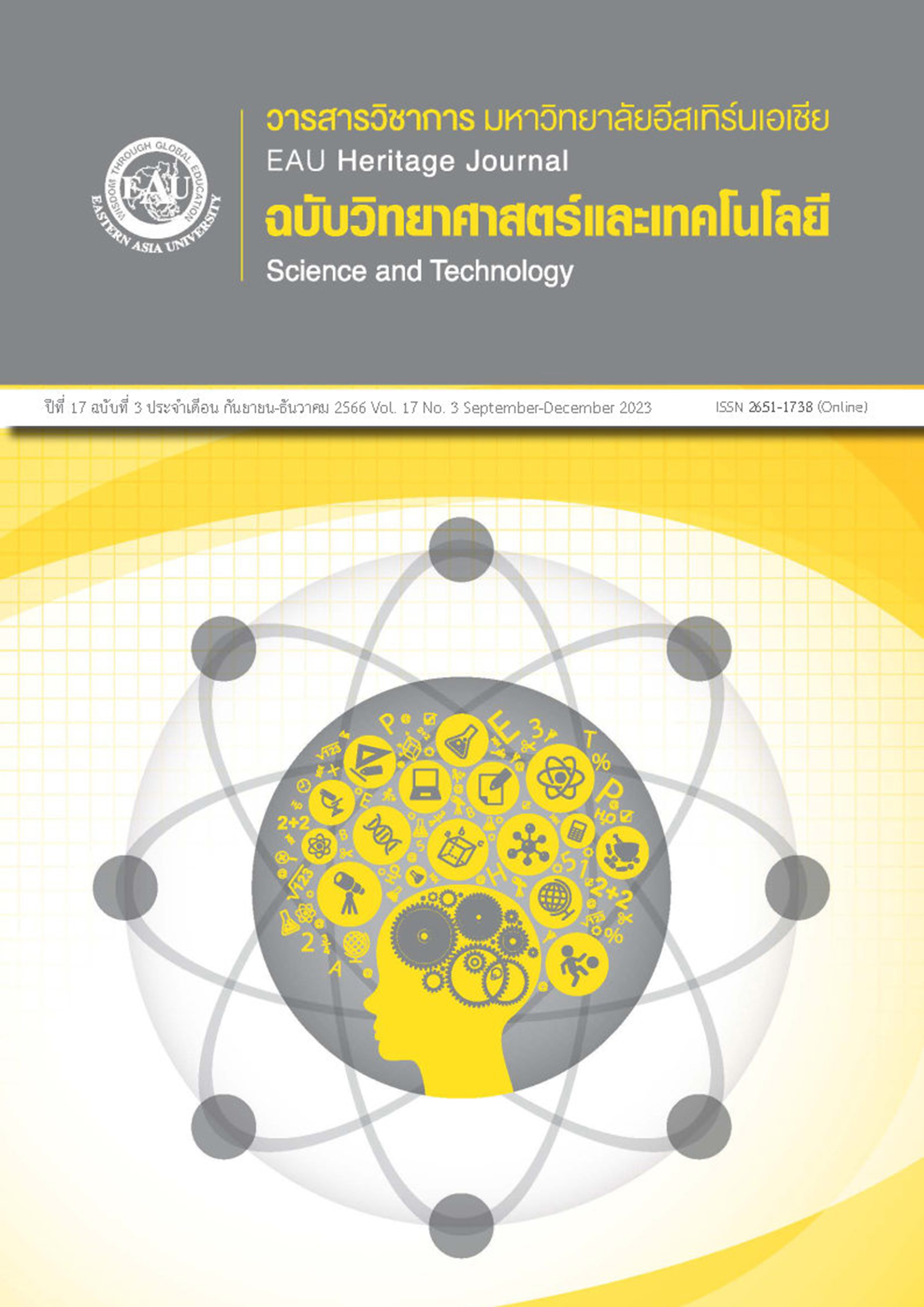การพัฒนาผลิตภัณฑ์เสริมอาหารโพลิแซคคาไรด์จากเห็ดรวมในรูปแบบผงชงดื่ม
คำสำคัญ:
ผลิตภัณฑ์เสริมอาหาร, โพลิแซคคาไรด์, เห็ด, ผงชงดื่มบทคัดย่อ
เห็ดเป็นอาหารและสมุนไพรที่มีการบริโภคมาอย่างยาวนานเนื่องจากเห็ดมีประโยชน์ต่อสุขภาพมากมาย เพื่อให้ได้รับประโยชน์ทางเภสัชวิทยาจากเห็ดจำเป็นต้องบริโภคเห็ดให้หลากหลายชนิดและปริมาณที่มากเพียงพอ การวิจัยครั้งนี้มีวัตถุประสงค์เพื่อพัฒนาสูตรตำรับและขั้นตอนการเตรียมผลิตภัณฑ์เสริมอาหารโพลิแซคคาไรด์จากเห็ดรวม (เห็ดนางฟ้าภูฐาน เห็ดนางรมฮังการีขาว เห็ดนางรมเทา และเห็ดหลินจือ) ในรูปแบบผงชงดื่ม โดยผลิตภัณฑ์ที่เตรียมได้มีลักษณะเป็นผงละเอียดสีขาวและมีผงสารสกัดเห็ดรวมสีน้ำตาลกระจายตัวอยู่อย่างสม่ำเสมอ ตำรับที่เลือกมาพัฒนาต่อ (E3) มีขนาดอนุภาคส่วนใหญ่อยู่ในช่วง 300-400 ไมโครเมตร มีการกระจายขนาดสม่ำเสมอ ความสามารถในการไหลอยู่ในระดับค่อนข้างดี ร้อยละความชื้น 4.38 ซึ่งอยู่ในเกณฑ์มาตรฐานที่ยอมรับได้ (ร้อยละ 1-5) สามารถละลายน้ำได้ดี โดยหากละลายในน้ำอุ่น (60 องศาเซลเซียส) จะละลายได้ดีกว่าน้ำอุณหภูมิปกติ (25 องศาเซลเซียส) และมีความหนืดต่ำกว่า จากผลการทดสอบความคงตัวของผลิตภัณฑ์แบบสภาวะเร่ง ที่อุณหภูมิ 40±2 องศาเซลเซียส ร้อยละความชื้นสัมพัทธ์ 75±5 เป็นระยะเวลา 1 เดือน พบว่า ผลิตภัณฑ์เห็ดรวมในบรรจุภัณฑ์แบบซองฟอยล์อะลูมิเนียม มีน้ำหนักและลักษณะทางกายภาพที่ไม่เปลี่ยนแปลงจากผลิตภัณฑ์ก่อนนำมาทดสอบความคงตัว และเพื่อให้ผลิตภัณฑ์เสริมอาหารเสริมโพลิแซคคาไรด์จากเห็ดรวมในรูปแบบผงชงดื่มมีปริมาณสารอาหารที่ครบถ้วนทั้งชนิดและปริมาณจึงเพิ่มผงถั่วลันเตาทำให้ได้ตำรับที่ดีที่สุดที่ประกอบด้วย สารสกัดโพลิแซคคาไรด์จากเห็ดรวม 25 มิลลิกรัม กรดไขมันอิ่มตัวสายกลางแบบผงร้อยละ 15 น้ำตาลทรายร้อยละ 5 หญ้าหวานร้อยละ 1.5 ผงถั่วลันเตาร้อยละ 40 และมอลโทเดกซ์ทรินร้อยละ 38.5 โดยน้ำหนัก ซึ่งเป็นตำรับที่มีสารอาหารครบถ้วน มีสมบัติทางกายภาพและรสชาติดีเหมาะสมในการพัฒนาต่อในระดับอุตสาหกรรมเพื่อจำหน่ายในเชิงพาณิชย์ต่อไป
เอกสารอ้างอิง
Alam, N., Amin, R., Khan, A., Ara, I., Shim, M. J., Lee, M. W., Lee, U. Y., & Lee, T. S. (2009). Comparative effects of oyster mushrooms on lipid profile, liver and kidney function in hypercholesterolemic rats. Mycobiology, 37(1), 37-42. https://doi.org/10.4489/MYCO.2009.37.1.037
Badole, S. L., Shah, S. N., Patel, N. M., Thakurdesai, P. A., & Bodhankar, S. L. (2006). Hypoglycemic Activity of Aqueous Extract of Pleurotus pulmonarius. in Alloxan-Induced Diabetic Mice. Pharmaceutical Biology, 44(6), 421-425. https://doi.org/10.1080/13880200600794196
Balaji, P., Madhanraj, R., Rameshkumar, K., Veeramanikandan, V., Eyini, M., Arun, A., Thulasinathan, B., Al Farraj, D. A., Elshikh, M. S., Alokda, A. M., Mahmoud, A. H., Tack, J. C., & Kim, H. J. (2020). Evaluation of antidiabetic activity of Pleurotus pulmonarius against streptozotocin-nicotinamide induced diabetic wistar albino rats. Saudi Journal of Biological Sciences, 27(3), 913-924. https://doi.org/10.1016/j.sjbs.2020.01.027
Bangkok Bank SME. (2021). After COVID-19, the nutritional supplement market has surged over 20 billion baht. Retrieved from https://www.bangkokbanksme.com/en/supplement-food-after-growth-covid-19 (in Thai)
Bernaś, E., Jaworska, G., & Lisiewska, Z. (2006). Edible mushrooms as a source of valuable nutritive constituents. Acta Scientiarum Polonorum Technologia Alimentaria, 5(1), 5-20.
Chiu, K., Lam, A., & Pang, P. (1995). Cardiovascular active substances from the straw mushroom, Volvariella volvacea. Phytotherapy research, 9(2), 93-99. https://doi.org/10.1002/ptr.2650090203
Falandysz, J., & Borovička, J. (2013). Macro and trace mineral constituents and radionuclides in mushrooms: health benefits and risks. Applied microbiology and biotechnology, 97, 477-501. https://doi.org/10.1007/s00253-012-4552-8
Farzana, T., Mohajan, S., Saha, T., Hossain, M. N., & Haque, M. Z. (2017). Formulation and nutritional evaluation of a healthy vegetable soup powder supplemented with soy flour, mushroom, and moringa leaf. Food science & nutrition, 5(4), 911-920. https://doi.org/10.1002/fsn3.476
Ghaly, I. S., Ahmed, E. S., Booles, H. F., Farag, I. M., & Nada, S. A. (2011). Evaluation of antihyperglycemic action of oyster mushroom (Pleurotus ostreatus) and its effect on DNA damage, chromosome aberrations and sperm abnormalities in streptozotocin-induced diabetic rats. Global Veterinaria, 7(6), 532-544.
Gu, Y.-H., & Sivam, G. (2006). Cytotoxic effect of oyster mushroom Pleurotus ostreatus on human androgen-independent prostate cancer PC-3 cells. Journal of medicinal food, 9(2), 196-204. https://doi.org/10.1089/jmf.2006.9.196
Isai, M., Elanchezhian, R., Sakthivel, M., Chinnakkaruppan, A., Rajamohan, M., Jesudasan, C. N., Thomas, P. A., & Geraldine, P. (2009). Anticataractogenic effect of an extract of the oyster mushroom, Pleurotus ostreatus, in an experimental animal model. Current Eye Research, 34(4), 264-273. https://doi.org/10.1080/02713680902774069
Iwalokun, B., Usen, U., Otunba, A., & Olukoya, D. (2007). Comparative phytochemical evaluation, antimicrobial and antioxidant properties of Pleurotus ostreatus. African Journal of Biotechnology, 6(15), 1732-1739. https://www.ajol.info/index.php/ajb/article/view/57767
Jedinak, A., Dudhgaonkar, S., Jiang, J., Sandusky, G., & Sliva, D. (2010). Pleurotus ostreatus inhibits colitis-related colon carcinogenesis in mice. International journal of molecular medicine, 26(5), 643-650. https://doi.org/10.3892/ijmm_00000509
Jong, S., & Birmingham, J. (1992). Medicinal benefits of the mushroom Ganoderma. Advances in applied microbiology, 37, 101-134. https://doi.org/10.1016/S0065-2164(08)70253-3
Jose, N., Ajith, T. A., & Janardhanan, K. K. (2002). Antioxidant, anti-inflammatory, and antitumor activities of culinary-medicinal mushroom Pleurotus pufmonanus (Fr.) Quel.(Agaricomycetideae). International Journal of Medicinal Mushrooms, 4(4). https://doi.org/10.1615/IntJMedMushr.v4.i4.60
Kaleem, M. A., Alam, M. Z., Khan, M., Jaffery, S. H. I., & Rashid, B. (2021). An experimental investigation on accuracy of Hausner Ratio and Carr Index of powders in additive manufacturing processes. Metal Powder Report, 76, S50-S54. https://doi.org/10.1016/j.mprp.2020.06.061
M EL-Fakharany, E., M Haroun, B., Ng, T., & M Redwan, E.-R. (2010). Oyster mushroom laccase inhibits hepatitis C virus entry into peripheral blood cells and hepatoma cells. Protein and peptide letters, 17(8), 1031-1039. https://doi.org/10.2174/092986610791498948
Manzi, P., & Pizzoferrato, L. (2000). Beta-glucans in edible mushrooms. Food chemistry, 68(3), 315-318. https://doi.org/10.1016/S0308-8146(99)00197-1
Ngai, P. H., Zhao, Z., & Ng, T. (2005). Agrocybin, an antifungal peptide from the edible mushroom Agrocybe cylindracea. Peptides, 26(2), 191-196. https://doi.org/10.1016/j.peptides.2004.09.011
Opaliński, I., Chutkowski, M., & Hassanpour, A. (2016). Rheology of moist food powders as affected by moisture content. Powder Technology, 294, 315-322. https://doi.org/10.1016/j.powtec.2016.02.049
Pak, S., Chen, F., Ma, L., Hu, X., & Ji, J. (2021). Functional perspective of black fungi (Auricularia auricula): Major bioactive components, health benefits and potential mechanisms. Trends in Food Science & Technology, 114, 245-261. https://doi.org/10.1016/j.tifs.2021.05.013
PPTV Online. (2022). Dietary supplements market has grown to nearly 80 billion Thai people willing to pay more than a thousand baht per month. Retrieved from https://www.pptvhd36.com/news/%E0%B9%80%E0%B8%A8%E0%B8%A3%E0%B8%A9%E0%B8%90%E0%B8%81%E0%B8%B4%E0%B8%88/179358 (in Thai)
Srimuk, W. (2007). Remarkable mushroom facts. Retrieved from http://www.dss.go.th/dssweb/st-rticles/files/bsp_12_2550_Mushroom.pdf (in Thai)
United States Pharmacopeial Convention. (2016). U.S. Pharmacopeia national formulary 2017: USP 40 NF 35 (Vol. 1). United States: United States Pharmacopeial Convention.
Zhang, Y., Dai, L., Kong, X., & Chen, L. (2012). Characterization and in vitro antioxidant activities of polysaccharides from Pleurotus ostreatus. International journal of biological macromolecules, 51(3), 259-265. https://doi.org/10.1016/j.ijbiomac.2012.05.003







